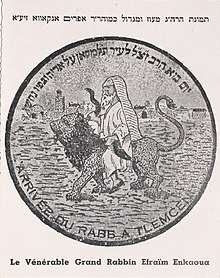Ephraim Alnaqua
Rabbi Ephraim ben Israel Alnaqua (1359-1442)[1] (Hebrew: אפרים בן ישראל אלנאקוה, romanized: Efrayim ben Yisra'el 'alnakuvah) (also, "Al-Nakawa", "Al-Nakava", "Ankava", "Ankoa", "Enkaoua", "Alnucawi", etc., Hebrew: "נקוה", "אלנאקוה", "אנקווה", "אנקאווא") was a physician, rabbi, theological writer, and founder of the Jewish community at Tlemçen (Algeria), where he died in 1442.

According to a legend, Alnaqua escaped from the Spanish Inquisition, which had martyred his father (rabbi Israel Ben Joseph)[1] and mother at the stake, and came to Tlemcen mounted on a lion, using a serpent as a halter. Azulai refers to him as a miracle-worker. Alnaqua succeeded, after all other physicians had failed, in curing the only daughter of a king of the Zayyanid dynasty. Refusing the reward of gold and silver offered him by the king, he begged only that the Jews living near Tlemçen might be united in it. In this way the community was formed. Alnaqua's first care was to establish a large synagogue: this is still in existence, and bears his name.[2] Above the rabbi's chair, on which the verse Jer. xvii.12 is engraved, a lamp burns perpetually. Alnaqua's grave, surrounded by those of his family, is in the old cemetery: it is sacred to North African Jews, and is frequently visited by pilgrims from all Algeria.[3]
Alnaqua had two sons, Israel and Judah. The latter lived at Oran, Mostaganem, and, later, at Tlemçen, and became the father-in-law of Simeon ben Zemah Duran. Alnaqua wrote for his elder son Israel Shaar Kevod Adonai (Entrance to the Glory of God), containing answers to the criticisms of Nahmanides on the Moreh of Maimonides. Manuscripts of this work exist in the Bodleian Library, Oxford. He wrote, also, some hymns.
Other Family Members
- Israel Alnaqua
- Jacky N'Kaoua, aka Papi Jacky [4]
Jewish Encyclopedia bibliography
- Azulai, Shem ha-Gedolim, s.v.;
- Benjacob, Oẓar ha-Sefarim, p. 599;
- Neubauer, Cat. Bodl. Hebr. MSS. Nos. 939, 2; 1258, 2;
- Revue Africaine, 1870, pp. 377–383;
- Zunz, Z. G. p. 435;
- idem, Literaturgesch. p. 524.
References
- Jean-Luc Allouche; Jean Laloum (1987). Les Juifs d'Algérie: images et textes. Editions du Scribe. p. 222. ISBN 978-2-86765-008-6.
- Jewish Folklore and Ethnology Review. Simon Bronner. 1990. p. 85. IND:30000046694455.
- support@publishersrow.com, (C)2001-2017, Varda Graphics. "Volume 1, The Universal Jewish Encyclopedia - eBook - free preview". www.publishersrow.com.
- "L'heritage du Rab Ephraïm Aln'Kaoua, le rav de Tlemcen". www.terredisrael.com.

External links
![]()